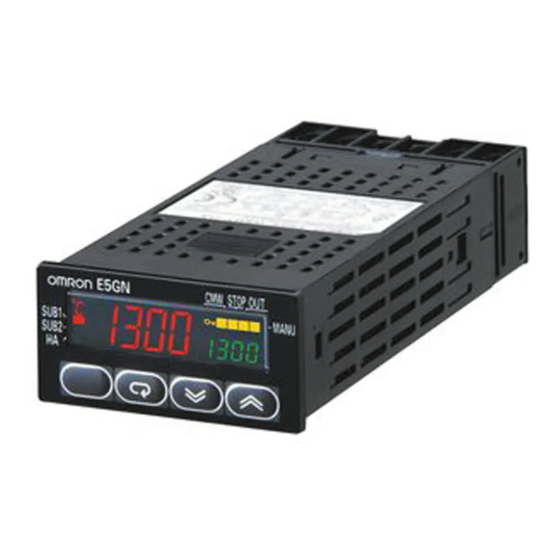
Table of Contents
Advertisement
Quick Links
Digital Temperature Controller
Compact and Intelligent 1/32 DIN
Temperature Controller with
Communications Function
Auto-tuning and self-tuning available.
Can auto-tune even during execution of
self-tuning
Various temperature inputs:
thermocouple, platinum resistance
thermometer, non-contact temperature
sensor, and analog inputs
Water-resistant construction: NEMA4
(equivalent to IP66)
Conforms to UL, CSA, IEC and CE
Ordering Information
E5GN STANDARD MODELS
IMPORTANT: The heating/cooling function, event input function, and heater burnout alarm are NOT available with the E5GN.
Description
Size
Power supply
voltage
1/32 DIN
100 to 240 VAC
48(W)
48(W) x 24(H) x
24(H)
100(D) mm
24 VAC/VDC
No. of
Output
alarm
points
---
Relay
Voltage output
(for driving SSR)
1
Relay
Voltage output
(for driving SSR)
---
Relay
Voltage output
(for driving SSR)
1
Relay
Voltage output
(for driving SSR)
Part number
Thermocouple model
E5GN-RTC AC100-240
E5GN-QTC AC100-240
E5GN-R1TC AC100-240
E5GN-Q1TC AC100-240
E5GN-RTC AC/DC24
E5GN-QTC AC/DC24
E5GN-R1TC AC/DC24
E5GN-Q1TC AC/DC24
E5GN
Platinum resistance
thermometer model
E5GN-RP AC100-240
E5GN-QP AC100-240
E5GN-R1P AC100-240
E5GN-Q1P AC100-240
E5GN-RP AC/DC24
E5GN-QP AC/DC24
E5GN-R1P AC/DC24
E5GN-Q1P AC/DC24
Advertisement
Table of Contents

Summarization of Contents
Product Overview and Ordering
E5GN Standard Models
Information on standard E5GN models, including features and ordering details.
Communication Models
E5GN Communication Model Specifications
Details for E5GN communication models, part numbers, and specifications.
Input Range Specifications
Thermometer and Thermocouple Input Ranges
Defines input ranges for resistance thermometers and thermocouples.
Technical Specifications
Ratings and Characteristics
Covers supply voltage, power consumption, accuracy, and operational characteristics.
Extended Specifications and Compliance
EMC, Approval Standards, and Communications
EMC, safety approvals, and communication interface specifications.
Nomenclature and Controls
Operation Indicators and Display Units
Explanation of device indicators and display elements.
Keypad Functionality
Description of each key's function for operation and setting.
Dimensions and Mounting
Physical Dimensions and Panel Cutout
Details on the controller's physical size and panel mounting requirements.
Mounting Configurations
Explains options for single unit and group mounting.
Installation and Wiring Guide
Mounting and Terminal Plate Handling
Instructions for installing the unit and managing the terminal plate.
Wiring Connections and Precautions
Guidance on wiring terminals and important safety precautions.
Operation and Initial Setup
Initial Setup Procedures
Guide to configuring basic settings using the setup menus.
ON/OFF Control Operation Example
Practical example of parameter adjustments for ON/OFF control.
PID Control with Auto-tuning
PID Control Setup Example
Step-by-step instructions for setting up PID control via auto-tuning.
Specification Setting Overview
Operation Procedure Outline
Flowchart showing navigation between operation levels.
Description of Parameter Levels
Explains the different parameter access levels (Operation, Adjustment, Initial).
Advanced Settings and Protection
Protect, Communications, and Calibration Levels
Details on protection, communications, advanced function, and calibration levels.
Initial Setting Level Parameters
Parameter Flow and Configuration
Illustrates the sequence of parameters within the Initial Setting Level.
Input Type Configuration
Thermocouple Input Type Specifications
Specifications for various thermocouple input types and temperature ranges.
Resistance Thermometer Input Type Specs
Details for Pt100 and JPt100 resistance thermometer inputs.
Alarm Configuration Options
Alarm Types and Output Logic
Lists and explains the 12 available alarm types and their output operations.
Parameter Navigation and Display
Parameter Access Flowchart
Visual guide to navigating parameters in different operational modes.
Detailed Parameter Settings
Initial Setting Level Parameters
Specific parameters for initial setup, including input, control, and alarm types.
Adjustment Level Parameters
Parameters for auto-tuning, PID settings, hysteresis, and cooling coefficients.
Protection and Access Control
Initial Setting/Communications Protection
Settings to restrict access to initial and communications setup levels.
Setting Change Protection
Controls modification of parameters via front panel keys.
Communications Setting Level
Communications Parameter Configuration
Setup for unit number, baud rate, data bits, stop bits, and parity.
Troubleshooting and Tuning Features
Error Codes and Troubleshooting
Identifies error codes and provides countermeasures for issues.
Fuzzy Self-tuning (ST) Function
Explains the automatic PID tuning capability of the controller.
Precautions and Installation Advice
Operating Environment and Service Life
Guidelines for operating conditions and expected component life.
Installation and Wiring Precautions
Important advice on mounting, connections, and preventing interference.









Need help?
Do you have a question about the E5GN-Q1T and is the answer not in the manual?
Questions and answers